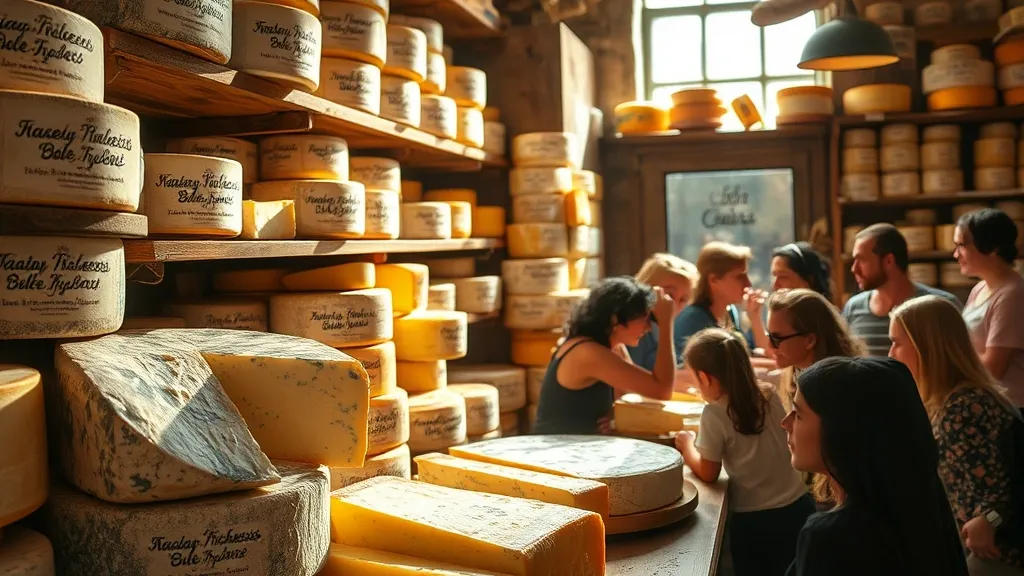The Aroma Avengers: Meet the Microbes Behind the Stench
Alright, let’s dive into the funky world of cheese. You know that smell that hits you when you open a wedge of Roquefort or Epoisses? It’s like a flavor explosion that some folks adore and others, well, not so much. But here’s the thing: that pungent aroma isn’t just random—it’s a whole squad of microbes doing their thing. Yep, let’s give a round of applause to the unsung heroes of the cheese world, the microbes!
First up, we’ve got lactic acid bacteria. These little guys are like the backbone of cheese-making. They munch on lactose and produce lactic acid, which helps in curdling the milk. But that’s just the beginning. As they break down proteins and fats, they release a whole bunch of flavor compounds. Some of these compounds can smell downright funky, but in a good way—if you’re into that sort of thing.
- Brevibacterium linens: This one’s a celebrity in the stinky cheese realm. It gives washed-rind cheeses like Limburger and Munster their distinctive aroma. Think of it as the life of the party, breaking down proteins and creating that strong smell. Some say it smells like feet, but hey, beauty is in the eye (or nose) of the beholder, right?
- Penicillium candidum: This is the mold that covers soft cheeses like Brie and Camembert. It’s not just there for looks; it contributes to the creamy texture and a bit of that earthy aroma we often associate with these cheeses. Moldy? Maybe. Delicious? Absolutely!
- Propionibacterium: These guys are responsible for the nutty flavor found in Swiss cheese. They produce carbon dioxide, which creates those iconic holes. So next time you see a Swiss cheese slice, remember: it’s got a little help from its microbial friends!
Now, I know what you’re thinking—how can something that smells like dirty socks be good? Well, it’s all about balance. The same microbes that create those strong aromas also produce complex flavors that make your taste buds dance. It’s a love-hate relationship for many, but those who are into it often can’t get enough.
So, the next time you pop open a stinky cheese, take a moment to appreciate the tiny workers behind that bold aroma. They’re doing their best to create something that’s not just food, but an experience. And who knew that a bit of bacteria could bring so much joy (or confusion) to our cheese boards?
Chemical Concoctions: How Aging Transforms Milk into Funk
Alright, so let’s dive into the wild world of cheese aging. You might be wondering how milk, that innocent liquid we pour over cereal, can turn into something that smells like a gym sock left in a sauna. Seriously, it’s a transformation that’s both fascinating and a little gross, but hey, that’s cheese for ya!
When cheese ages, it’s like a science experiment gone deliciously right (or wrong, depending on your nose). The process starts with bacteria, which are basically the little party animals of the cheese world. These critters feast on lactose, breaking it down into lactic acid. That’s the good stuff, but the real fun begins when they start producing all kinds of funky compounds. We’re talking about everything from ammonia to butyric acid, which is the same stuff found in rancid butter. Yum, right?
As the cheese continues to age, more bacteria and enzymes get involved in the party. They break down proteins and fats into amino acids and fatty acids, and guess what? This is where the magic—or shall I say, the funk—happens. Some of these compounds have super strong smells. Ever heard of isovaleric acid? It’s what gives certain cheeses that footy aroma. I mean, who knew cheese could be so… human?
- Smell: The more time cheese spends aging, the more pronounced its odor becomes.
- Texture: Aging also affects the cheese’s texture. It can go from creamy to crumbly, which adds to the overall experience.
- Taste: And let’s not forget about taste! The aging process can intensify flavors, sometimes leading to a complex, nutty profile.
Now, some folks might be put off by the smell, but for cheese lovers, it’s like a badge of honor. The stinkier, the better! It’s a little like a fine wine; you’ve gotta embrace the funk to truly appreciate what’s happening. Plus, it makes for great conversations at parties. “Oh, you can smell that cheese? That’s just its personality shining through!”
So, next time you take a whiff of that pungent cheese, remember it’s not just a random smell—it’s a whole world of chemistry happening in that little wedge. And honestly, who doesn’t love a good story about how something went from fresh to funky? Embrace the funk, my friends!
The Unlikely Allure: Why We Crave What We Shouldn’t
You ever notice how the stinkiest cheeses seem to have this weird magnetic pull? It’s like they’ve got a secret club with the most exclusive membership, and we’re all just lining up to get in. There’s something oddly fascinating about foods that smell like they’ve been through the wringer—especially cheese. You’d think we’d steer clear of anything that smells like it could walk off the plate, but nope, we dive right in. Why is that?
One reason might be the whole “forbidden fruit” vibe. You know, the idea that if something’s considered bad or stinky, it must be good. Think about it: when was the last time you heard someone say, “Oh, I can’t wait to try that mild, odorless cheese”? Exactly. The funkier the cheese, the more daring it feels to taste it. It’s like a badge of honor to say you’ve tried something that smells like a gym locker.
Then there’s the science part of it. Our brains are wired to find pleasure in the unexpected. Stinky cheeses, like Roquefort or Limburger, have these intense flavors that can be a rollercoaster for your taste buds. The smell might initially make you go, “What the heck is that?!” but when you finally take a bite, it’s often a whole different story. It’s like the cheese is whispering, “Trust me, I promise I’m worth it!”
- Fermentation: This is where the magic happens. As bacteria break down the proteins and fats, they create these complex flavors and smells that can be downright intoxicating.
- Umami Factor: Stinky cheeses are often rich in umami, that savory taste that makes you want to keep eating. It’s like your taste buds are having a party and everyone’s invited.
- Culture and Tradition: Many of these cheeses have deep-rooted histories and cultural significance. Trying them can feel like indulging in a piece of history.
And let’s be real, there’s something just a bit rebellious about eating a cheese that smells bad. It’s like saying, “I’m not afraid to enjoy life a little differently.” Who cares if your friends raise an eyebrow when you pull out a wedge of something that could clear a room? You’re the adventurous one, the brave cheese explorer. So go on, embrace the stink! It’s all part of the experience, and who knows? You might just find your new favorite snack.
From Curds to Curiosity: The Cultural Significance of Smelly Cheese
Okay, let’s talk about smelly cheese for a sec. I mean, who doesn’t love a good whiff of a pungent cheese that could probably power a small village? It might seem weird at first, but there’s actually a lot of cultural significance wrapped up in those funky aromas. Think about it: cheese has been around for centuries, and people all over the world have developed an affection for the stinky stuff. It’s like a rite of passage, right? You either love it, or you’re not quite ready to take that plunge.
In many cultures, strong-smelling cheeses are more than just a snack; they’re a statement. For instance, take France. They’ve got a whole category of cheeses that could probably be classified as “aroma bombs.” From Roquefort to Epoisses, these cheeses are celebrated for their scents and flavors that can take you on a wild ride. It’s like cheese tourism in your mouth! And don’t get me started on how pairing them with wine can make you feel like a total connoisseur. You take a sip, a bite, and suddenly you’re like, “Ah yes, the notes of barnyard are really coming through.” Who knew barnyard could be a compliment?
- Historical Roots: Many cultures have roots that intertwine with cheese-making traditions. Think about the Swiss and their fondue. Who knew a pot of melted cheese could be a cultural icon, right?
- Community Gatherings: Smelly cheeses often show up at gatherings and celebrations. It’s like the cheese is saying, “Hey, I’m here for a good time!”
- Artisanal Craft: The process of making these cheeses is an art form. Every stinky cheese has its own story, and the makers often pour their heart (and a bit of sweat) into it.
Plus, there’s something about the boldness of smelly cheese that just screams confidence. If you can take a bite of a cheese that smells like gym socks and enjoy it, you’ve basically conquered your taste buds. It’s liberating! But hey, I get it—some folks aren’t ready for that level of adventure. It’s all about finding your cheese comfort zone, and that’s totally cool.
So, whether you’re a die-hard fan of stinky cheese or just dipping your toe into the world of strong flavors, there’s no denying the cultural significance of these odorous delights. They’re more than just food; they’re a conversation starter, a cultural experience, and sometimes, a test of bravery. Cheese lovers unite!




